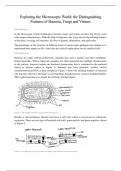Essay
Distinguising features of bacteria, fungi and viruses.
- Vak
- Instelling
This document is an essay I wrote for the module 'Molecules to Cells', it describes the differences between fungi, bacteria and viruses with the aid of handdrawn diagrams.
[Meer zien]



